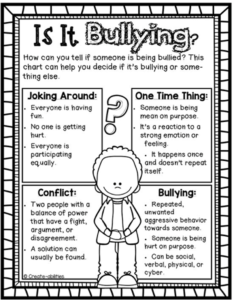Children are excited to go back to school to meet their friends while parents are relieved to send their kids to school as they get their time. However, with all the joy and excitement, ups and downs, children and parents are equally concerned about school bullying. In this article let’s learn what bullying means, types of bullying and how can kids and parents address it.
What is bullying?
According to stopbullying.gov, “Bullying is unwanted, aggressive behaviour among school aged children that involves a real or perceived power imbalance. The behaviour is repeated, or has the potential to be repeated, over time. Both kids who are bullied and who bully others may have serious, lasting problems.”
How to identify if one is bullied?

Types of bullying:
There are three types of bullying:
- Verbal bullying is saying or writing mean things. Verbal bullying includes:
- Teasing
- Name-calling
- Inappropriate sexual comments
- Taunting
- Threatening to cause harm
- Social bullying, sometimes referred to as relational bullying, involves hurting someone’s reputation or relationships. Social bullying includes:
- Leaving someone out on purpose
- Telling other children not to be friends with someone
- Spreading rumors about someone
- Embarrassing someone in public
- Physical bullying involves hurting a person’s body or possessions. Physical bullying includes:
- Hitting/kicking/pinching
- Spitting
- Tripping/pushing
- Taking or breaking someone’s things
- Making mean or rude hand gestures
Where and when can bullying can happen?
Bullying can happen during and after school hours, while in the classroom, school corridors, playground, bus and can also happen in neighborhood.
What Kids Can Do
It can be quite overwhelming for children when bullied. They will be scared, hurt and confused. They won’t be sure how to handle the situation. Empowering them handling bullies and situations will build confidence in them and handle the situations better. Here are few things parents can do to empower your kids and keep them safe from bullying.
How to respond to bullies
- Learn to respond and not react
- Tell bully “ I do not like it” or “can you please stop it” in a calm, assertive and clear voice.
- You can try to just ignore the bully
- If speaking up seems too hard or not safe, walk away and stay away.
- Don’t fight back. Find an adult to stop the bullying on the spot.
There are things you can do to stay safe in the future, too.
- Talk to an adult you trust. Don’t keep your feelings inside. Telling someone can help you feel less alone. They can help you make a plan to stop the bullying.
- Stay away from places where bullying happens.
- Stay near adults and other kids. Most bullying happens when adults aren’t around.
Treat Everyone with Respect:
Teach kids to treat everyone with respect. Nobody should be mean and hurt others.
- Stop and think before you say or do something that could hurt someone.
- If you feel like being mean to someone, find something else to do. Play a game, watch TV, or talk to a friend.
- Talk to an adult you trust. They can help you find ways to be nicer to others.
- Keep in mind that everyone is different. Not better or worse. Just different.
- If you think you have bullied someone in the past, apologize. Everyone feels better.
Stand Up for others
When you see bullying, there are safe things you can do to make it stop.
- Talk to a parent, teacher, or another adult you trust. Adults need to know when bad things happen so they can help.
- Be kind to the kid being bullied. Show them that you care by trying to include them. Sit with them at lunch or on the bus, talk to them at school, or invite them to do something. Just hanging out with them will help them know they aren’t alone.
Not saying anything could make it worse for everyone. The kid who is bullying will think it is ok to keep treating others that way.
Protect yourself from Cyberbullying
Bullying does not always happen in person. Cyberbullying is a type of bullying that happens online or through text messages or emails. There are things you can do to protect yourself.
- Always think about what you post. You never know what someone will forward. Being kind to others online will help to keep you safe. Do not share anything that could hurt or embarrass anyone.
- Keep your password a secret from other kids. Even kids that seem like friends could give your password away or use it in ways you don’t want. Let your parents have your passwords.
- Think about who sees what you post online. Complete strangers? Friends? Friends of friends? Privacy settings let you control who sees what.
- Keep your parents in the loop. Tell them what you’re doing online and who you’re doing it with. Let them friend or follow you. Listen to what they have to say about what is and isn’t okay to do. They care about you and want you to be safe.
- Talk to an adult you trust about any messages you get or things you see online that make you sad or scared. If it is cyber bullying, report it.
Get Involved
You can be a leader in preventing bullying in your community.
- Find out more about where and when bullying happens at your school. Think about what could help. Then, share your ideas. There is a good chance that adults don’t know all of what happens. Your friends can go with you to talk to a teacher, counsellor, coach, or parent and can add what they think.
- Talk to the principal about getting involved at school. Schools sometimes give students a voice in programs to stop bullying. Be on a school safety committee. Create posters for your school about bullying. Be a role model for younger kids.
- Write a blog, letter to the editor of your local newspaper, or tweet about bullying.
Source: Stopbullying.gov
IMG Source: Pinterest

